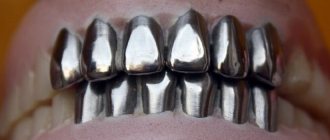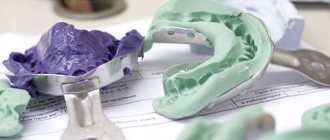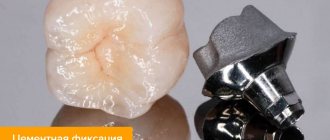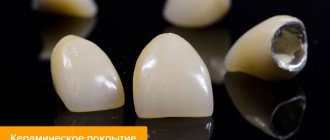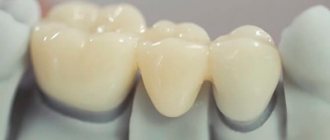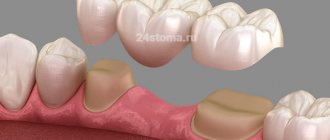- Materials
- Indications
- Contraindications
- Manufacturing and installation
- Advantages and disadvantages
- Care
- Life time
- Alternative Methods
- Advantages of the ROOTT Clinic
- Prices
- Work examples
- Doctors
- Reviews
- When to use:
any group of teeth - Material:
KHS, gold, silver, palladium - Installation time:
2 to 5 days - Features:
minimal tooth grinding, low price, short service life - Service life:
up to 3 years - Anesthesia:
local
Stamped dental crowns are the oldest in the family of single metal dentures. For a long time, stamping was the only method for manufacturing orthopedic systems. Today, such structures can confidently be called a relic of the past. Structurally, they do not differ from similar prostheses; they are made in the form of a steel cap, 0.2-0.3 mm
, which is fixed to the prepared dental unit.
The production of stamped crowns does not require complex technology. Dentures are created manually, from cylindrical metal caps - factory blanks, sleeves. The dental laboratory has steel sockets of different diameters and thicknesses. The technician selects a blank suitable in diameter and begins stamping the crown. Typically, prosthetic structures are gray or golden in color (depending on the material). At the request of the patient, the prosthesis is coated with gold, titanium nitrite, and lined with plastic or ceramic mass for better aesthetics.
What is a stamped metal crown?
Externally, the thin-walled structure resembles the shape of an incisor or molar
A stamped metal crown is an orthopedic prosthesis used in the dental industry to restore dentition.
Externally, the thin-walled structure resembles the shape of an incisor or molar.
This type of prosthetics is used when the root is preserved, and the indication is to partially restore the functionality of the tooth and prevent its further destruction.
The technology for making a prosthesis is the simplest: a shape is tapped from a blank-sleeve that is as close as possible to the impression made on the patient’s jaw.
The thickness of the crown wall depends on the metal used in the manufacturing process of the product. The average value is 0.2-0.3 mm, which determines the parameters for grinding the tooth.
How long does adaptation take?
How long does it take to get used to stamped crowns? As a rule, adaptation takes very little time - a day or two. It all depends on how well the structure is made and how long the patient walked with a damaged tooth. Since the product follows the anatomical shape, there is no particular discomfort when getting used to it.
Complex on 4 OSSTEM implants with delayed loading - from RUB 170,000.
Complex implantation Osstem (South Korea) with delayed loading after 4-6 months.
Guarantee for the doctor’s work - unlimited Call now or order a call
Opening hours: 24 hours a day - seven days a week
Clinical and laboratory stages of manufacturing
The process of making crowns requires adherence to certain principles to ensure high-quality installation and minimal likelihood of complications:
- Trying on a finished crown
The orthopedic structure must at least partially perform the function of a tooth.
- There should not be large gaps when the crown touches the neck of the tooth. A small gap is filled with cement, but during wear it gradually collapses. A large gap will cause a number of problems, but a small space is considered normal.
- The prosthesis is fixed in such a way that the metal surface does not sink into the gum groove by more than 0.3 mm. Exceeding this indicator causes the development of marginal periodontal disease.
- When installing a metal structure, it is necessary to maintain the interalveolar interval in relation to the adjacent tooth. Otherwise, injury to a healthy unit or soft tissue may occur.
- The shape of the prosthesis should be close to the anatomical one so that the appearance of a number of teeth is not disturbed and there is no discomfort when wearing the product.
The production of an orthopedic structure includes clinical and laboratory work.
The clinical stages are carried out by an orthopedist in the following sequence:
- The specialist grinds the tooth and creates a stump.
- The choice of color and type of material is made together with the patient.
- Taking impressions from the jaw where the prosthesis is planned to be installed.
- Transferring data to the laboratory technician, where the prosthesis is manufactured.
- Fitting and correction of orthopedic construction.
- Fixing the product with cement mortar.
Laboratory work is carried out by a dental technician.
The stamping technology is as follows:
- Modeling a prosthesis using an impression.
- Obtaining a plaster model.
- To identify the correct ratio of units in the dentition, the model is fixed in the occluder, giving it the position of central occlusion.
- The model is covered with wax and a crown is modeled.
- Making a stamp from a gypsum composition.
- Selection of a suitable sleeve (size, color).
- Stamping of light alloy crowns.
- Transfer the product to the orthopedist for fitting.
- If necessary, perform correction, as well as final grinding and polishing.
How are dentures made?
- Therapeutic treatment of the tooth is carried out after its preparation.
- An impression of both jaws is made using plaster or alginate. Plaster impressions are gradually becoming a thing of the past as obsolete; the use of alginate is preferable.
After this, the dentist begins to work closely in the dental laboratory.
- He is given a model of the dentition of both jaws cast in plaster, on which, in case of problems with the bite, the central relationship for its correction is determined.
- Plaster of Paris is placed in the occluder.
- A plaster stamp is cut out of the wax model that is then created, and then a metal one is made according to its sample.
- The sleeve-blank is selected as precisely as possible according to the size of the cast die.
The fact is that the sleeves are produced according to average parameters, and in order to fit the prepared stamp exactly to the tooth stump, there are two ways: choose the exact size or reduce it from the available ones. The sleeve is put on the second die and the fitting work begins, which includes thermal and mechanical effects on the workpiece.
The final check of the finished crown is done in the clinic, where, after fitting, they look at how tightly it fits (without taking into account the future cement layer) to the neck of the tooth. Defects are identified, then the outer surface is ground. If the patient expresses a desire, titanium nitride will be sprayed onto the steel surface.
At the last stage, the finished crown is dried using alcohol treatment, the cement is diluted and injected inside, and it is forcefully pressed onto the tooth stump. To do this, you just need to clench your jaw tightly. The squeezed out excess cement is removed.
Kinds
There are several types of metal structures:
- Dentures are installed in the presence of a destroyed tooth fragment, when it is not possible to install a filling or inlay
Stamped - made on the basis of caps (sleeves) with subsequent giving the workpiece the anatomical shape of the patient’s tooth;
- Cast - the manufacturing process includes casting molten metal into a prepared mold, this makes it possible to obtain precise parameters of the prosthesis and a high-strength product;
- Brazed - the manufacturing technology resembles a stamped one, but the sleeve is first cut into 2-3 parts, after tapping it is joined together by soldering (this method is used in cases where it is not possible to give an anatomical shape to the whole sleeve).
Prices
Free online consultation with a dentist
| Service | Price |
| Installation of a metal-ceramic crown (Germany Ivoclar, cobalt-chrome) | from 15,000 rub. |
| Installation of a metal-ceramic crown based on a bio-alloy - gold (Ivoclar Germany + cost of material according to the certificate) | from 25,000 rub. |
Consultation and diagnostics are free!
All prices Promotions
Sign up for a consultation
three ROOTT specialists + diagnostics as a gift
Installation of stamped metal crowns
Fixation of crowns is carried out only after treatment of identified dental diseases. The prosthetic process involves tooth preparation, but the layer of bone tissue removed is minimal compared to other methods of restoring the dentition.
Preparatory work is carried out in the following sequence:
- Removing the top layer of enamel (0.3 mm). The work is performed with a special diamond disc.
- After preparation, the orthopedist checks the gaps between the causative and contacting teeth. The interval should correspond to the thickness of the crown. Control is carried out using a wax sheet.
- The next step is to prepare all contact surfaces (adjustment to the thickness of the crown).
- The process is completed by preparing the oral and vestibular parts of the tooth in order to give the stump a cylindrical shape. The diameters of the stump and neck of the tooth must be the same.
Installation of a crown made of stamped metal is carried out in the following order:
- examination by a doctor of the oral cavity to ensure the absence of inflammatory processes;
- quality control of preparatory work;
- fixing the crown to the stump by applying cement to the joint.
Upon completion of prosthetics, the doctor gives recommendations to the patient on caring for the oral cavity and, in particular, the crown.
Stages of crown installation
Contraindications
Relative
the procedure can be carried out with extreme caution
- Bite defects;
- increased abrasion of the enamel of the antagonist tooth;
- gum pathologies (atrophic, inflammatory);
- pregnancy;
- allergy to anesthetics;
- acute infections;
- mental disorders;
- exacerbation of a chronic disease.
Absolute
the procedure is strictly prohibited
- Severe periodontitis with tooth mobility grade III-IV;
- malignant processes of the oral cavity;
- allergy to prosthesis material;
- decompensated diabetes mellitus.
Advantages and disadvantages
When choosing the type of crown, it is necessary to compare the existing positive qualities, properties of the material and its disadvantages.
This will relieve discomfort and disappointment in the process of wearing an orthopedic design:
| Characteristics of a stamped metal crown | |
| pros | Minuses |
| Simple technology for making a crown. | Over time, the cement on which the structure sits deteriorates. This leads to the formation of gaps between the dentin and the prosthesis. |
| Possibility of using the structure without preliminary depulping. | The layer of stamped metal is insignificant, so while the crown is worn, its surfaces wear out. |
| The duration of the treatment process does not take much time. | This type of prosthetics does not restore the functionality of the tooth due to the inability to recreate the anatomical shape of a molar or incisor. |
| Low installation requirements, which allows the use of a stamped design even in cases where another type of prosthetics is contraindicated for a number of reasons. | Dentures made of stamped metal do not provide a tight fit to soft tissues, which provokes the penetration of food particles under the structure, where a favorable environment for caries and other diseases develops. |
| During the process of prosthetics, dental tissue is ground, but a minimal layer is removed (0.3 mm). | The aesthetic side of metal products leaves much to be desired. Such a jaw is unlikely to decorate a smile. |
| The use of a stamped metal product is the most affordable type of prosthetics. | |
There are plenty of pros and cons of a stamped prosthesis, but during the analysis it becomes clear that this type, due to its accessibility and simplicity of manufacturing technology, has the right to exist.
Dental laboratory
- Own laboratory
The FDC clinic has its own dental laboratory, equipped with the latest technology, so even the most labor-intensive orthopedic work is performed in the shortest possible time.
- Laboratory in France
Exclusive work, if necessary, can also be performed in the most prestigious dental laboratory in France, Bourbon Atelierd' Art Dentaire (Nice)
Price
Prices for stamped dentures vary depending on the regional location of the clinic and the presence/absence of a sprayed layer
A wide selection of modern materials is gradually replacing the installation of stamped crowns from the list of services of some clinics.
But the presence of an interested segment of consumers still hinders the final refusal to use this material in prosthetics.
Prices for stamped dentures differ depending on the regional location of the clinic and the presence/absence of a sprayed layer.
The cost of a regular crown is 1,500 rubles. You will have to pay a little more for a product with spraying (1,700 rubles). In the case of making a crown with plastic lining, the price will increase to 2000 rubles.
Alternative Methods
Ceramic-composite metal-free, lightweight crowns with high light transmittance
Zirconium Durable crowns with high aesthetics, suitable for anterior and posterior teeth
Cast Durable and durable one-piece crowns made of metal alloys with the possibility of veneering
Article Expert
Shirokov Ivan Yurievich Dentist-orthopedist, doctor of the highest category
Work experience: more than 17 years
Features of care
Special care for crowns made from stamped metal is not required. The main measures include regular hygiene procedures and thorough cleaning of the oral cavity after eating food.
The list of recommended products includes:
- paste and brush with medium-hard bristles;
- rinse balm;
- dental floss.
After smoking cigarettes or drinking coffee, you need to rinse your mouth with a special liquid; in extreme cases, you can get by with water.
Every six months you need to visit the dental clinic to monitor the integrity of the prosthesis and for thorough cleaning of the oral cavity, which can only be provided by professional cleaning.
Such measures will help prevent the formation of plaque and the growth of stones. Also, based on a number of signs, a specialist can promptly identify the problem and prescribe treatment.
User Questions
QUESTION Tell me, I have a gray crown on a molar that seems to be stamped. I noticed that the gum area around me was very red. Does this mean it’s time to change the crown or what? Sergey Anatolyevich
ANSWER Hello, Sergey Anatolyevich. Here you need to look at the situation - it is advisable to go to an orthopedist and get an x-ray. It is possible that food gets stuck under the gum, which is why it becomes inflamed. It is also possible that you have an allergy to metal. Perhaps some diseases have appeared under the roots, or cement has dissolved under the crown - and microbes penetrate into the resulting niche. After diagnosis, the dentist will make a verdict - whether the gum can be cured without removing the crown or not.
1Haug S. Correct modeling, 2006.
Author: Sambuev B. S. (Thank you for your help in writing the article and the information provided)
Durability
Experts recommend not to wait for complications to arise and to consult a doctor promptly.
The metal alloy stamping is quite thin, so during the operation of the crown it wears out quickly.
The surface, which is often in contact with other teeth, is subject to abrasion.
This explains the short service life, which is indicated by 3-5 years.
Fragility is due to other factors:
- the presence of a gap between the structure and dentin, which provokes the development of caries and other dental problems;
- crown deformation as a result of eating hard foods.
Experts recommend not waiting for complications caused by the above reasons to occur.
Every 2-3 years, crowns simply need to be replaced with new ones, even if the old ones have not yet lost their aesthetic appearance. It is difficult to assess the condition of dentin under the structure, so there is a need for revision.
Errors
- If, when installing a crown, the gingival edge turns pale, then it must be shortened with scissors and a bur, since the design puts too much pressure on the tissue
- If the prosthesis is not put on and it is clear that the diameter of the stump is larger than it should be, then selective preparation can be carried out by removing the interfering areas of the tooth
- If the prosthesis does not fit on due to problems inside the stamping itself or is loose, then it is sent to the laboratory for alteration
- If the structure is too short and does not fit into the gingival sulcus, then you need to start by taking the impression again and repeat all the laboratory steps
Anesthesia
In order to numb the desired area, modern dentistry uses several methods of anesthesia, as well as some types of anesthetics. The method of anesthesia that is carried out along the nerve trunk, as well as by injecting an anesthetic with a special needle into the mucous parts of the gums, is very popular.
Anesthesia
These types of anesthesia require close attention from a specialist, as well as strict adherence to all necessary precautions. This is necessary in order not to infect the patient, as well as to prevent infection with various types of viral infections transmitted through blood - hepatitis viruses or immunodeficiency viruses.
When carrying out pain relief measures, several types of solutions are used:
- "Lidocaine";
- "Xylocytin";
- "Artikain";
- "Ubistezin";
- "Ultracaine".
"Lidocaine" solution
The most effective among the above-mentioned medicinal anesthetics is Ultracaine. This drug perfectly freezes the part of the gum that needs to be treated and keeps it frozen for a long time.
- Grinding of teeth for metal-ceramics
It also happens that the patient feels anxious and cannot pull himself together before the procedures. For this purpose, premedication is provided, which consists of administering small doses of tranquilizers to the patient to relieve anxiety symptoms. Premedication is given 30-45 minutes before anesthesia.
Premedication in dentistry
For premedication, some drugs from the following list are given:
- "Phenibut";
- "Mebicar";
- "Tazepam";
- "Elenium";
- "Diazepam."
"Elenium"
In modern techniques, in order to significantly increase the effect of anesthetics, the addition of vasoconstrictor drugs is used. These substances are capable of spasmodic vessels along the bloodstream, which are located in the periphery. This leads to local oxygen starvation in the tissues at the injection site. This reduces the excitability and conductivity of nerve fibers.
It has been proven that the use of vasoconstrictors in modern methods of dental procedures leads to a decrease in the effect of toxic substances contained in the anesthetic. And the painkiller itself is required several times less.
Vasoconstrictors
Vasoconstrictor drugs used in dental practice are:
- a hormone produced by the adrenal cortex - adrenaline;
- a hormone produced by the pituitary gland - vasopressin.
It also happens that total general anesthesia is necessary. This technique is used quite rarely and is necessary for the following indications:
- patient intolerance to local anesthesia or complete lack of pain relief effect;
- diseases associated with the nervous system, leading to convulsive contractions (chorea, hyperkinesis).
General anesthesia
To use general anesthesia, the drug “Rotilan” is used; it has a fairly pronounced, but at the same time mild effect. It is also important that the specialist does not lose contact with the patient.
Treatment under general anesthesia
In order to avoid touching soft tissue when grinding hard parts of a tooth, the specialist must know well what depth is maximum for a certain part of each tooth.

